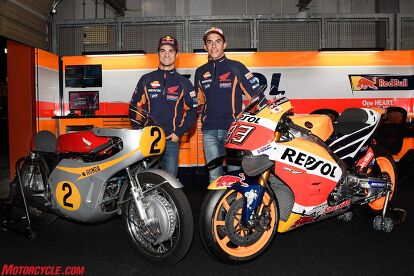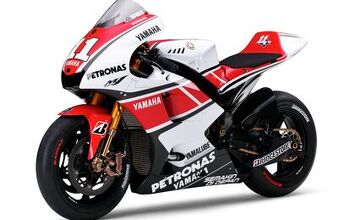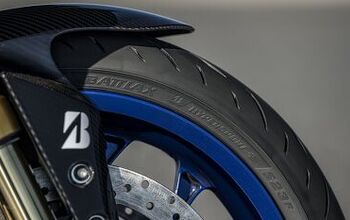Honda Celebrates 50 Years In The Premier Class Of Grand Prix Racing
The 2016 MotoGP season marks a halfcentury since Honda first contested the premier class of World Championship motorcycle racing. During much of that time (Honda did not participate between 1968 and 1978) bike racing’s most challenging category has been like a university to Honda engineers and riders, teaching them so much about all aspects of motorcycle design and development.
The class of kings has also brought Honda a huge amount of success: 270 race wins and 38 500cc and MotoGP Riders World Championships and Constructors World Championships. [At the end of the 2015 season]
Honda entered the premier 500cc class for the first time in 1966, seven years after the company made its World Championship debut in the 1959 Isle of Man 125cc TT. Since then Honda has repeat the development and victory to achieved a record total of more 700 race wins across all five classes: MotoGP/500cc, 350cc, 250cc, 125cc and 50cc. Since 1966 a total of 31 riders have won 500cc/MotoGP races riding Honda machinery.
Honda also holds the records for the most premierclass victories in one season: 15 wins in 1997 and 2003, 14 wins in 2002 and 2014 and 13 wins in 1996, 1998 and 2011.
RC181: the story of Honda’s first premierclass Grand Prix motorcycle
Honda’s firstever premierclass Grand Prix bike made its race debut 50 years ago in May 1966. Considering its fabulously exotic stablemates – including the sixcylinder 250cc RC166 and the five cylinder 125cc RC149 – the RC181 was a relatively straightforward motorcycle. The mighty machine utilised typical Honda engine architecture: four cylinders inline and canted forward, with gear driven cams operating four valves per cylinder. Its first incarnation gave rider Jim Redman 85 horsepower at 12,500rpm for a top speed of almost 170mph.
Redman began Honda’s premierclass career in style, beating Giacomo Agostini (MV Agusta) at Hockenheim on May 22nd 1966. Badly outgunned, MV unleashed an overbored version of its lightweight 350 triple for the following Dutch GP where Redman rode an inspired race to defeat the Italian once again. It seemed Redman was on course to fulfilling Honda’s dream of conquering the 500 class.
But one week later at SpaFrancorchamps Redman crashed in the rainlashed Belgian Grand Prix. “There was a lake of water – the machine aquaplaned and down I went at over 250km/h,” said Redman who was badly battered in the accident and later announced his retirement.
With Redman out, Honda threw its weight behind Mike Hailwood, who already had experience in the 250, 350 and 500 classes. At Assen Hailwood crashed while leading and at Spa he was robbed of success by gearbox gremlins. At Brno he inflicted a decisive defeat on Ago, but at Imatra in Finland he came home second after running off the track. Hailwood won again at the Ulster and at the Isle of Man, so if he scored one more victory at the season finale in Italy the title would be Honda’s, even though he had missed the first three rounds. Hailwood and Ago duelled for victory at Monza, until the RC181 broke an exhaust valve.
Honda/MV rivalry was now at its peak, but despite the intense competition the two teams enjoyed a relationship of mutual respect that verged on friendliness.
“We exchanged presents sometimes,” remembers Honda’s teamleader Michihiko Aika.
“MV would give us Italian wine and we would give them dried seaweed from Japan.”
Hailwood may have failed to win the premierclass title but 1966 was year the factory managed the unique achievement of winning all five Constructors World Championships (500cc, 350cc, 250cc, 125cc and 50cc), while Hailwood won the 350 and 250 riders titles and Swiss ace Luigi Taveri took the 125 crown.
“That season was our golden era, even though we only had a few staff in the team,” Aika recalls. “We had a maximum of 12 staff at the Isle of Man, and that included engine designers, chassis designer and all the mechanics, we had no drivers or helpers. We did everything ourselves, looking after 30 machines, six for each class.”
The enormous effort of contesting all five motorcycling World Championships and also the Formula 1 car series took its toll, so Honda withdrew from the 125 and 50 classes before the 1967 season. Honda had entered F1 for the first time in 1964, won its first race in 1965 and planned a full assault on the 1967 F1 series with former bike champion John Surtees, driving Honda’s three litre V12.
Aika started the 1967 motorcycle season with just a handful of staff and with Hailwood attacking the 250, 350 and 500 series alone.
The RC181 was improved for its second campaign, growing 10cc to 499cc, for even more power. However, the bike broke its crank at the opening Hockenheim race, while Hailwood was well ahead of Agostini’s MV. The following month The Briton won a famous victory over Ago at the Isle of Man TT, establishing a lap record that stood for many years. Ago fought back to win the next two races at Spa and the Sachsenring, then Hailwood beat the Italian at Brno by 17 seconds. Hailwood crashed out at Imatra and led the way at Monza, until he was slowed by gearbox issues. He won again at the season finale at Mosport in Canada, but it wasn’t enough. Ago took the title with a secondplace finish.
In February 1968 Honda announced its withdrawal from all motorcycle Grand Prix classes to focus on development of seminal motorcycles like CB750 four as well as Formula 1 and the car market. The CB750 was the world’s first superbike. It was launched in 1969, when Honda’s annual motorcycle production reached 1.5 million units for the first time.
To date, Honda has won 277 500cc / MotoGP grands prix (at the end of Round 14 this season), and 38 riders and constructors titles. The RC181 is the machine that marks Honda’s first step into successfully competing in the premier class.
More by Press Release



































Comments
Join the conversation